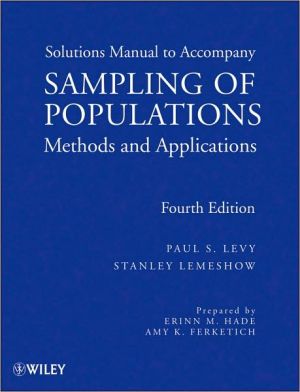Sampling of Populations: Methods and Applications
"Sampling of Populations, Fourth Edition continues to serve as an all-inclusive resource on the basic and most current practices in population sampling. Maintaining the clear and accessible style of the previous edition, this book outlines the essential statistical methods for survey design and analysis, while also exploring techniques that have developed over the past decade." The Fourth Edition guides the reader through the basic concepts and procedures that accompany real-world sample...
Search in google:
A trusted classic on the key methods in population sampling—now in a modernized and expanded new edition Sampling of Populations, Fourth Edition continues to serve as an all-inclusive resource on the basic and most current practices in population sampling. Maintaining the clear and accessible style of the previous edition, this book outlines the essential statistical methodsfor survey design and analysis, while also exploring techniques that have developed over the past decade. The Fourth Edition successfully guides the reader through the basic concepts and procedures that accompany real-world sample surveys, such as sampling designs, problems of missing data, statistical analysis of multistage sampling data, and nonresponse and poststratification adjustment procedures. Rather than employ a heavily mathematical approach, the authors present illustrative examples that demonstrate the rationale behind common steps in the sampling process, from creating effective surveys to analyzing collected data. Along with established methods, modern topics are treated through the book's new features, which include: A new chapter on telephone sampling, with coverage of declining response rates, the creation of "do not call" lists, and the growing use of cellular phones A new chapter on sample weighting that focuses on adjustments to weight for nonresponse, frame deficiencies, and the effects of estimator instability An updated discussion of sample survey data analysis that includes analytic procedures for estimation and hypothesis testing A new section on Chromy's widely used method of taking probability proportional to sizesamples with minimum replacement of primary sampling units An expanded index with references on the latest research in the field All of the book's examples and exercises can be easily worked out using various software packages including SAS®, STATA®, and SUDAAN, and an extensive FTP site contains additional data sets. With its comprehensive presentation and wealth of relevant examples, Sampling of Populations, Fourth Edition is an ideal book for courses on survey sampling at the upper-undergraduate and graduate levels. It is also a valuable reference for practicing statisticians who would like to refresh their knowledge of sampling techniques. Doody Review Services Reviewer:Leon F Burmeister, PhD(University of Iowa College of Public Health)Description:This book is designed for a one-semester course, primarily for students in public health and applied statistics. The third edition was published in 1999.Purpose:The book clearly addresses a basic need in academic and applied research.Audience:In addition to the students who would benefit from this book, professionals working in areas that require samples of human populations would also find the concepts and examples helpful.Features:The book develops the basic sampling designs used in estimation of population characteristics. It is effective because of the many examples and exercises, the organization that collects and summarizes important formulas in several boxes in nearly all of the chapters, and the illustration of computer packages (SAS and STATA) throughout. Adding chapters on telephone surveys and sample weight construction would make the book much more useful. The suggested answers to odd-numbered exercises are expanded and will be very helpful to students and practitioners.Assessment:Although the fourth edition improves several aspects, there are concerns. Few chapters have new exercises. More importantly, few new references have been added. For some very specialized techniques, such as network sampling, lack of references describing recent applications is a limitation in both the classroom and the field. In spite of these limitations, the book compares favorably to similar textbooks because of its inclusion of an adequate number of realistic exercises and its many illustrations of computer applications. Although the small number of new exercises and references is disappointing, the fourth edition does increase the utility of the book.
TablesBoxesFiguresGetting Files from the Wiley ftp and Internet SitesList of Data Sites Provided on Web SitePt. 1 Basic Concepts 11 Uses of Sample Surveys 32 The Population and the Sample 11Pt. 2 Major Sampling Designs and Estimation Procedures 433 Simple Random Sampling 454 Systematic Sampling 835 Stratification and Stratified Random Sampling 1216 Stratified Random Sampling: Further Issues 1437 Ratio Estimation 1898 Cluster Sampling: Introduction and Overview 2239 Simple One-Stage Cluster Sampling 23110 Two-Stage Cluster Sampling: Clusters Sampled with Equal Probability 26911 Cluster Sampling in Which Clusters Are Sampled with Unequal Probability: Probability Proportional to Size Sampling 33112 Variance Estimation in Complex Sample Surveys 367Pt. 3 Selected Topics in Sample Survey Methodology 39513 Nonresponse and Missing Data in Sample Surveys 39714 Selected Topics in Sample Design and Estimation Methodology 42715 Telephone Survey Sampling Michael W. Link Link, Michael W. Mansour Fahimi Fahimi, Mansour 45516 Constructing the Survey Weights Paul P. Biemer Biemer, Paul P. Sharon L. Christ Christ, Sharon L. 48917 Strategies for Design-Based Analysis of Sample Survey Data 517Appendix 537Answers to Selected Exercises 543Index 571
\ BooknewsWith a minimum of mathematical formality and technical jargon, provides a practical explanation of the basic concepts and procedures of sample design for professionals in statistics and surveys. Discusses such topics as systematic sampling and probability proportionate to size sampling, illustrating the logic involved through examples instead of mathematical proofs. Thoroughly expanded and revised from the 1980 Sampling for health professionals. Annotation c. Book News, Inc., Portland, OR (booknews.com)\ \ \ \ \ Reviewer: Leon F Burmeister, PhD(University of Iowa College of Public Health)\ Description: This book is designed for a one-semester course, primarily for students in public health and applied statistics. The third edition was published in 1999.\ Purpose: The book clearly addresses a basic need in academic and applied research.\ Audience: In addition to the students who would benefit from this book, professionals working in areas that require samples of human populations would also find the concepts and examples helpful.\ Features: The book develops the basic sampling designs used in estimation of population characteristics. It is effective because of the many examples and exercises, the organization that collects and summarizes important formulas in several boxes in nearly all of the chapters, and the illustration of computer packages (SAS and STATA) throughout. Adding chapters on telephone surveys and sample weight construction would make the book much more useful. The suggested answers to odd-numbered exercises are expanded and will be very helpful to students and practitioners.\ Assessment: Although the fourth edition improves several aspects, there are concerns. Few chapters have new exercises. More importantly, few new references have been added. For some very specialized techniques, such as network sampling, lack of references describing recent applications is a limitation in both the classroom and the field. In spite of these limitations, the book compares favorably to similar textbooks because of its inclusion of an adequate number of realistic exercises and its many illustrations of computer applications. Although the small number of new exercises and references is disappointing, the fourth edition does increase the utility of the book.\ \ \ From the Publisher“The book remains a very appropriately written text for classroom use, especially for students studying public health or epidemiology, or for undergraduate majors in statistics and related fields.” (Biometrics, June 2009)\ \








